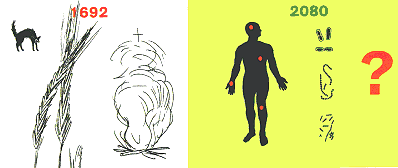Second opinions
Reproduced from the

Dr Mark Porter on how today's medical knowledge can help to explain historical conditions that were tragically misdiagnosed.
 Hindsight is one of the most powerful tools in medicine,
as demonstrated by Channel 4's Secrets of the Dead, which comes up
with a theory to explain the outbreak of witchcraft and possession that led
to trials in Salem, Massachusetts, more than 300 years ago. And it's not
just possession by evil spirits that can be explained with the benefit of
current knowledge... but let's start with Salem.
Hindsight is one of the most powerful tools in medicine,
as demonstrated by Channel 4's Secrets of the Dead, which comes up
with a theory to explain the outbreak of witchcraft and possession that led
to trials in Salem, Massachusetts, more than 300 years ago. And it's not
just possession by evil spirits that can be explained with the benefit of
current knowledge... but let's start with Salem.
Secrets of the Dead suggests that the people of Salem
were suffering from a form of poisoning caused by mouldy cereals, particularly
rye. The mould in question is Claviceps purpurae, which produces a
number of toxic ergot-based alkaloids that survive cooking and lead to a
form of poisoning known as ergotism (Saint Anthony's fire).
The most common form of ergotism is seen when people ingest
small amounts of contaminated flour over a longish period, leading to pins
and needles and burning in the extremities. Consuming large quantities in
a short time can lead to a more acute form, characterised by dizziness,
convulsions and hallucinations -just what happened to the poor people of
Salem, for whom rye was a staple food.

And it wasn't just poor villagers who suffered as a result of
medical ignorance - it affected the high and mighty, too. Take King George
III, whose reign was punctuated by periods of erratic behaviour and who is
now thought to have suffered from porphyria, a rare inherited glitch in
metabolism that leads to the build-up of toxins in the blood. Attacks tend
to be intermittent and are characterised by stomachaches, paralysis, odd
behaviour, delusions and hallucinations, seizures and difficulty in seeing.
One telltale sign is that the urine may turn deep red on standing - something
that must have been evident in the king's chamber pot, but which meant little
or nothing to the horde of physicians trying to cure him. Poor chap.
Sometimes scientists and doctors themselves are affected.
Antoine Henri Becquerel, the man credited with the discovery of
radioactivity at the end of the 19th century, is a classic example. Such
was his ignorance of the dangers of radiation that he once placed a vial
of radium in his pocket. The resulting burn on his leg took weeks to heal.
Becquerel and his co-workers still didn't catch on, though, and it was nearly
three decades before safe radiation exposure limits were introduced in 1934.
This ignorance cost more than 300 early radiation workers their lives and
most, including Marie Curie, developed leukaemia. Curie's notebooks
are dangerously radioactive even now.
The benefit of current medical knowledge has even been applied
to the world's leading artists. I remember a lecture at medical school in
which one of the country's leading ophthalmologists explained the painting
styles of many of the world's masters through a series of visual defects,
ranging from plain short-sightedness to astigmatisms and age-related macular
degeneration. He even used corrective lenses to demonstrate his point and
show how the paintings would have appeared to the artists in question.
And there is no reason to believe that hindsight in the year
2100 will prove any less revealing than it does today. Scientists and doctors
then will hopefully be able to laugh at how their predecessors struggled
to understand 20th-century epidemics such as cancer, heart disease, arthritis,
asthma and eczema.
Hindsight maybe a powerful tool, but it's not a particularly helpful one,
unlike a time machine... now we're talking.
Dr Mark Porter co-presents
Watchdog Healthcheck Mondays
BBC1 and is on Jimmy Young, alternate Mondays Radio 2.